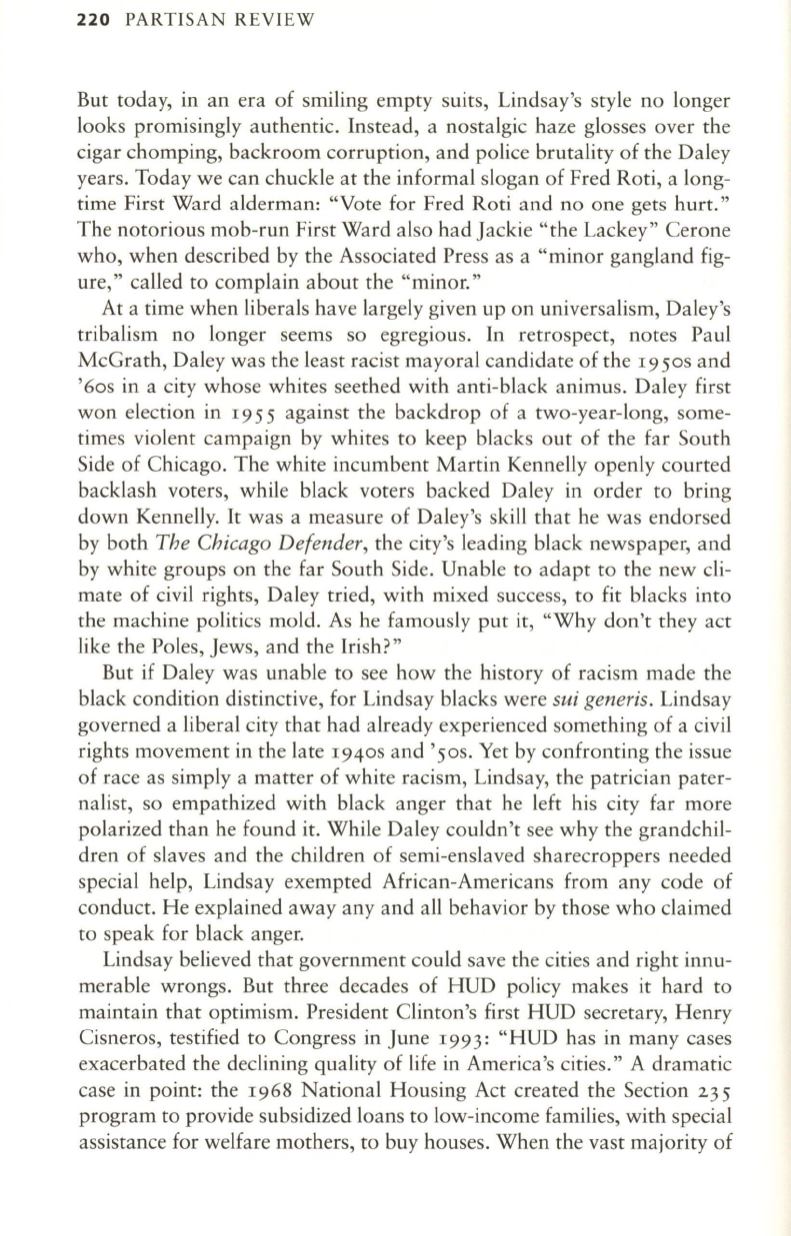
220
PARTISAN REVIEW
But today, in an era of smiling empty suits, Lindsay's style no longer
looks promisingly authentic. Instead, a nostalgic haze glosses over the
cigar chomping, backroom corruption, and police brutality of the Daley
years. Today we can chuckle at the informal slogan of Fred Roti, a long–
time First Ward alderman: "Vote for Fred Roti and no one gets hurt."
The notorious mob-run First Ward also had Jackie "the Lackey" Cerone
who, when described by the Associated Press as a "minor gangland fig–
ure," called
to
complain about the "minor."
At a time when liberals have largely given up on universalism, Daley'S
tribalism no longer seems so egregious.
In
retrospect, notes Paul
McGrath, Daley was the least racist mayoral candidate of the 19 50S and
'60S in a city whose whites seethed with anti-black animus. Daley first
won election in 1955 against the backdrop of a two-year-Iong, some–
times violent campaign by whites
to
keep blacks out of the far South
Side of Chicago. The white incumbent Martin Kennelly openly courted
backlash voters, while black voters backed Daley in order
to
bring
down Kennelly.
It
was a measure of Daley'S skill that he was endorsed
by both
The Chicago Defender,
the city'S leading black newspaper, and
by white groups on the far South Side. Unable to adapt to the new cli–
mate of civil rights, Daley tried, with mixed success, to fit blacks into
the machine politics mold. As he famously put it, "Why don't they act
like the Poles, Jews, and the Irish?"
But if Daley was unable to see how the history of racism made the
black condition distinctive, for Lindsay blacks were
sui generis.
Lindsay
governed a liberal city that had already experienced something of a civil
rights movement in the late 1940S and' 50S. Yet by confronting the issue
of race as simply a matter of white racism, Lindsay, the patrician pater–
nalist, so empathized with black anger that he left his city far more
polarized than he found it. While Daley couldn't see why the grandchil–
dren of slaves and the children of semi-enslaved sharecroppers needed
special help, Lindsay exempted African-Americans from any code of
conduct. He explained away any and all behavior by those who claimed
to speak for black anger.
Lindsay believed that government could save the cities and right innu–
merable wrongs. But three decades of HUD policy makes it hard to
maintain that optimism. President Clinton's first HUD secretary, Henry
Cisneros, testified to Congress in June 1993: "HUD has in many cases
exacerbated the declining quality of life in America's cities." A dramatic
case in point: the 1968 National Housing Act created the Section 235
program
to
provide subsidized loans to low-income families, with special
assistance for welfare mothers, to buy houses. When the vast majority of


